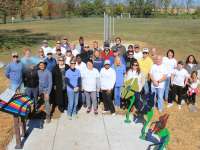Since the 1960s, children in the United States have been gaining weight at a steady and concerning rate. The number of adolescents who are overweight has tripled since 1980 and the prevalence among younger children has more than doubled. According to the 1999-2002 National Health and Nutrition Examination Survey survey, 16 percent of children ages 6-19 years are overweight. The link between childhood obesity, adult obesity, and eventually adult chronic disease is well known and poses significant epidemiological, economic, and societal concerns. Various strategies for early intervention toward improving physical well-being have been employed but long-term lifestyle solutions remain elusive. For example, physical education classes have been shown to generate an increase in activity at the time of the class but students tend to exercise less at other times during the school week and further have a noticeable effect on student health.
For many, this may indicate that structured environments and/or scheduled physical activity lack the factor of "enjoyment" which is the key to long term behavioral change. Activities such as these are often seen as things you "have to do" rather than things you "want to do." It is clear that innovative and unconventional strategies at affect health behaviors in positive and more immediate ways are needed. The American Pediatrics Society's Policy Statement highlights how the built environment of a community effects opportunities for physical activity and recommends that the government should create playgrounds, parks, and green spaces within communities as well as means to access them safely. Priority should be given to low-income neighborhoods to ensure that all children and adolescents have access to safe and desirable opportunities for play and active lifestyles.
The positive effects of play on manual dexterity, balance, and physical fitness are well documented. When combined with the natural environment, it has dramatic additional benefits for the cognitive, social, and emotional development of children and adolescents.
Play allows for creativity, confidence, decision-making, leadership, and social engagement skills. In fact, it has been suggested that encouraging unstructured play may be an exceptional way to increase physical activity levels in children, which is one important strategy in the resolution of the obesity epidemic.
Rather than developing new and expensive promotional campaigns which advocate redundant messages, we might look for answers through activities, and in places immediately before us. The vast interconnected outdoor recreation network of federal, state, and local lands and waters present a largely untapped resource which may be capable of helping to achieve this purpose. Combining inherently enjoyable and readily accessible activities such as play with simple, effective, health-related messaging may serve as a gateway to better lifelong health.
"Active play in outdoor environments is the gateway to a healthier lifestyle."
-Dr. Michael Suk
This article was written for Words on Play®: A treatise on its value by leading play scholars™ by Michael Suk, M.D., JD, MPH, FACS Associate Professor of Orthopaedic Surgery, University of Florida, Fmr. White House Fellow and Special Assistant to the Secretary (2003-2004), US Department of the Interior Visit Dr. Suk's bio.
Sources for this article can be found on pages 26-27 in Words on Play®.



